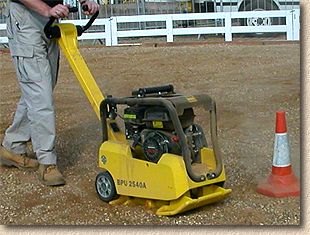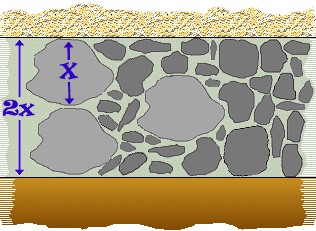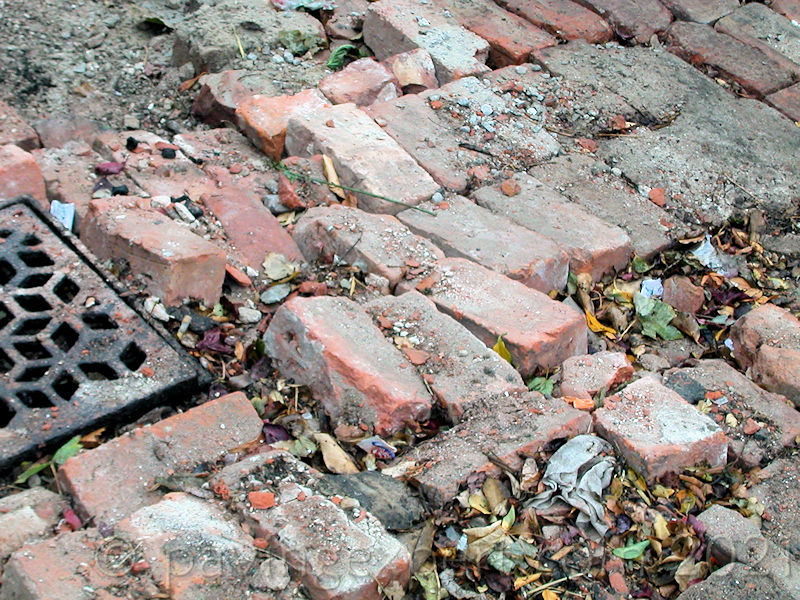Do I really need a Sub-base?
The short answer is: if the pavement will be trafficked by vehicles, then yes, but if it will be foot-traffic only, then not necessarily.
The type of paving or surfacing that will be used is one of the key factors in determining whether a sub-base will be required. Some paving types, block paving for example, nearly always need a sub-base, while others, such as pattern imprinted concrete, may not need one, but wouldn't be any less effective if one was to be included. See Table 1 below for a summary.
Bear in mind the comments made on the Introduction to Sub-bases regarding their role within a paved area, how they help spread loads and provide an 'underlay' to the 'carpet' of paving. You should only exclude a sub-base if there is good reason to do so.

Type of paving
Sub-base?
Thickness (mm)
Comments
Always
75-150
75mm min for foot traffic only,100-150mm for driveways,150mm+ for commercial applications
Occasionally
75-150
Not necessary for foot traffic, but may be used when constructing a driveway
Usually
75-150
Not necessary for patios, but may be used when constructing a driveway, and often specified for commercial works
Usually
100-150
Often omitted beneath PIC on driveways, which is not always a good idea
Table 1: Requirements for Sub-base and recommended thicknesses
How deep should my sub-base be?
Generally, a flexible sub-base of unbound material needs to be at least 100mm deep, as does a bound sub-base of CBM/HBM. For bitumen-bound material, then 50mm is a typical minimum thickness.
There's a 'rule of thumb' that we use with fill layers - they should always be at least twice the thickness of the largest particle size. This is done to ensure that no 'points' are created within a layer, that is, no particle or lump of stone can be in contact with both upper and lower surfaces at any time, but by definition must be 'cushioned' by finer material either above, below, or both above and below. This ensures that the layer acts to spread the loads it carries, but also ensures there are no 'rocking points' within the layer.

So, if maximum particle size is "x", then minimum layer thickness is "2x", as shown opposite.
DTp1 has, in theory, a maximum particle size of 37½mm, so using this 'rule of thumb', the min layer thickness would be 3½ × 2 = 75mm. If a fill layer or sub-base layer was using a 50mm crusher run material, then the minimum layer thickness/depth would be 50 × 2 = 100mm, and so on and so forth.
Conversely, if we know that we have space for only 50mm of fill material, then the maximum particle size would be 50 ÷ 2 = 25mm.
So, assuming a sub-base is going to be used, just how deep should it be? This is revealed in Table 2 below.
Project
Typical depth
Patios, Garden Paths
75-100mm
Driveways, public footpaths
100-150mm
Heavy uses
150-225mm
Highways
150mm +
Table 2: recommended sub-base depths using DTp1
Can I use old housebricks as a sub-base?
Sub-bases aren't included in a pavement just for fun - they are often the key load-bearing layer, and trying to save a few bob by using old house bricks or other rubbish you have lying around is often a false economy. How would you feel if a carpet fitter suggested using a few old tea towels under your living room carpet, instead of proper underlay, as it would save a bit on cost??
The trouble with using old bricks is that folk tend to chuck them in 'as is', whole bricks and half-bricks dumped haphazardly over the sub-grade, with hundreds of gaps and voids between them. The same goes for other so-called 'hardcore' such as old flagstones, edging kerbs, broken lumps of concrete and the like.
After a few weeks, any finer material used as additional fill, and/or the bedding material, starts to trickle down and settle into all those voids. And that's not an end to it - following this initial settlement, the outline of the bricks starts to show through, and so you find that, for instance, bitmac follows the ups and downs of the bricks, and flags start to 'rock' on the high points.

Even breaking them in half isn’t ideal. Although this does tend to reduce the problems, it doesn’t get rid of them altogether. What you need to do is break up the bricks into quarters or smaller – the smaller the better – and then ‘blind’ them with grit sand, rock fines or crushed stone, so that all the voids between the smashed bricks are filled, and then compact the lot, repeatedly running the vib plate or roller over the area until all the ‘fines’ are rattled into the voids and you have a reasonable ‘capping layer’.
You can then regulate the top of this layer with 75mm or more of quality sub-base material – a DTp1, DTp2, or a crusher-run material.
Skimping on the sub-base is one of the surest ways of shortening the life of any driveway. For what it costs, spending a few quid extra on quality sub-base material is a sound investment that will pay for itself over the years of extended service it enables.
